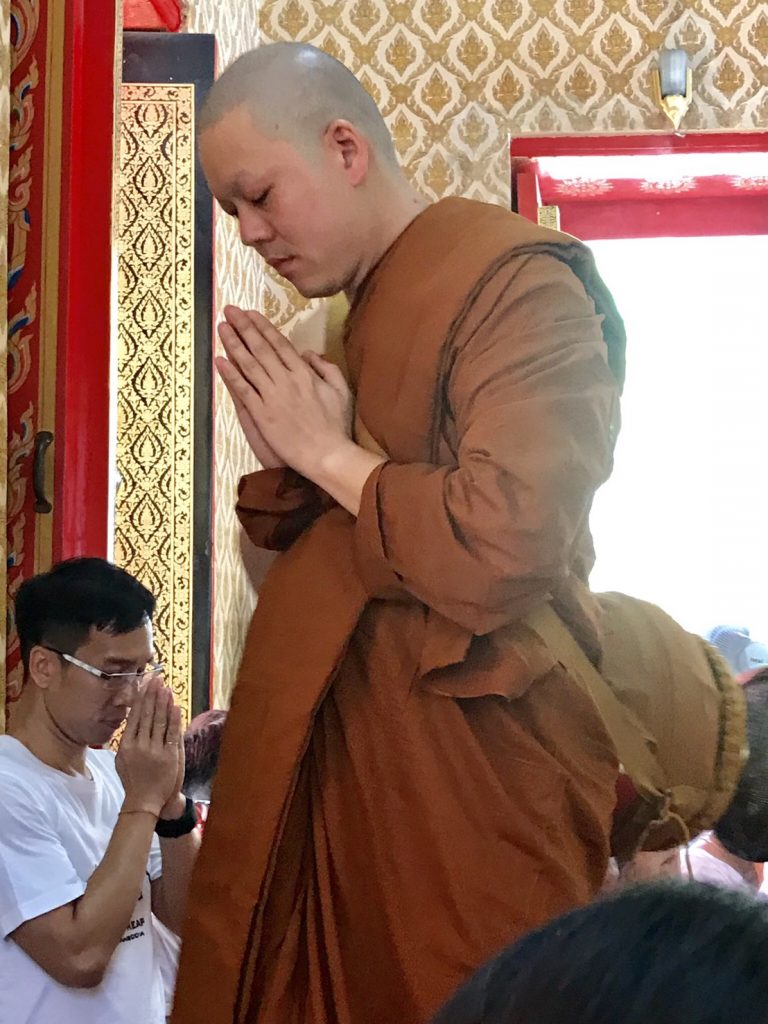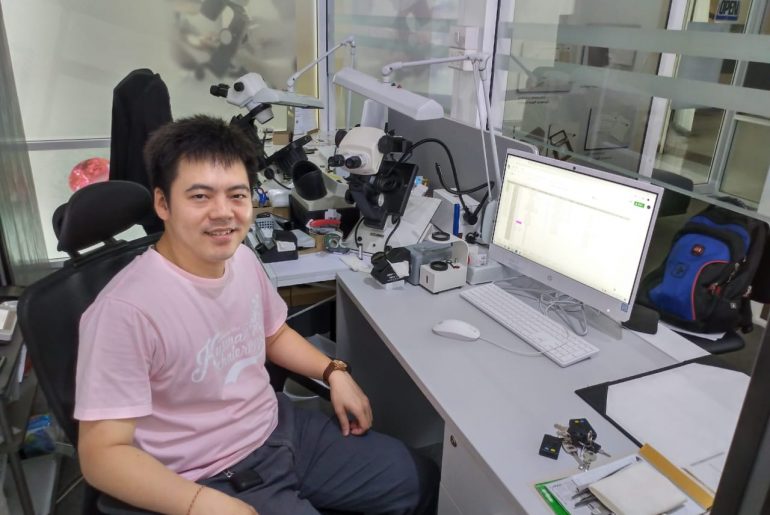Surachart Panjathammawit (Gem Monk) taught gemology for nearly 2 decades. He statred his carrer with GIA and later taught at AIGS(Bangkok). His students came from different corners of the world. Lets take a look at his journey.
1. Hello Ajarn surachart. Welcome to the First interview session of Little Gemologist. Can we know something about yourself? When did you start? How did you think of joining this field? Was it planned or it was sheer coincidence?
Ans- Honestly I did not think of joining this field. In my university I did undertake gems and jewellery course and few months before my graduation I planned to help my father in his business of automobile spare parts.
Before our final exams, Director of GIA (Thailand), came to our university and asked if any student was willing to work there. 10 students agreed and our interview was scheduled.
At that time I could not speak English very well. I was not expecting to get a job but as fate would have it I got accepted in GIA as an instructor.
2. So how long have you been in this field and how has been your journey teaching gemology?
Ans- It’s been 20 years as a teacher. I worked for GIA for close to 11 years and then I started teaching at AIGS (BANGKOK).
As far as my journey is concerned I’m very happy and satisfied. I feel that I’m not only teaching students about gemology, but also teaching something valuable which is going to help them in their life and their carrier.
3. Did you also try to become a trader or you were always interested in teaching side?
Ans- After I quit GIA, where I was teaching for nearly a decade, I tried to sell gems, and work as a trader, but after sometime I knew trading in gemstones was not for me. I’m not a good seller.
4. Gems and jewellery is a multi-billion dollar industry. But we do not see MANY world class educational institutes teaching gemology. There are only handful which are recognized internationally like AIGS (Bangkok), GIA, IGI and couple more. In fact there are more jewellery designing institutes than gemological institutes.
Ans- There are many reasons for this in my opinion:-
First, is it is difficult to find a good gemologist teacher.
Second, you need to have a very large sample of stones. There has to be variety in inclusions, variety in colour, you need all varieties of stones, all varieties of inclusions so that students can see and learn. You need good gemologist who can teach. There are many gemologists but few who can actually teach. And sometime you have good teachers but they are not good gemologist.
I like the AIGS style where in some course module they have teachers who do not have trade experience but for some modules like colour grading and pricing they have teachers who have experience in trade so they can give students a feel as to how things work in real market.
5. Many traders feel that gemological courses are expensive considering their time period. Fees which is paid for a full gemologist diploma (for 6-7 months) runs in thousands of dollars.
Ans- I understand why they think that way. In a sense, yes, I agree it is expensive. But on other hand if u distribute the fees over a period of entire life, which a trader will spend selling stones I think it is justified. Gemstones are expensive and one wrong purchase will set u back by thousands of dollars. So if you do 2-3 such mistakes money lost will cover your entire fee which you save by not taking gemology education.
6. Do you think 6-7 months time is enough to teach gemology?
Ans- I think it’s enough to get a good solid foundation of what gemology is and what you will be dealing with. But 6-7 months are not enough to be expert.
7. There have been many treatments in gemstones like heat,beryllium,hpht etc. How difficult you think it is to teach students about identifying these treatments considering they don’t use libs,ftir in classroom.
Ans- I always tell my students that there are some treatments which are easy to detect with the help of standard equipment and for some you need to send stones to a gem lab for further testing.
8. What is the easiest and most difficult thing to teach to students?
Ans- As a teacher I think everything is easy to teach but one thing which is most difficult to teach or make students understand is to go step by step. Don’t take shortcuts. I know students want to learn a lot but they cannot rush or jump the line. They need to know the basics, practise them and then go for advanced techniques. Because one mistake is a lot of money in this field.
9. What you feel about colour grading? Is my red your red as well?
Ans- No. It’s completely subjective. We study colour grading for the market and we need to know the majority of opinion prevalent in the market.
Labs provide the role of colour grading because buyer and seller they don’t both agree on colour grading by respective parties. So labs fulfil the role of a 3rd bi-partisan party who makes the transaction of buying and selling easy by saying colour of stone is blue,pigeon blood red or violet blue.
10. Are you comfortable with words like muzo green, cornflower blue or pigeon blood instead of intense blue, vivid blue or bright green?
Ans- I agree with this idea of what you are saying. But as I said earlier labs follow the market trend. Words like pigeon blood; cornflower blue has been used in trade for long time already. So traders already know what muzo green or cornflower blue looks like. But I agree that labs should balance their reports and not only think of market. Some labs give pigeon blood to all rubies as they want more people to come to them and get their stone tested.
11. Given the complex nature of treatments in gemstones, do you think in coming years it will be difficult to teach students how to detect them in classrooms, as treatments are getting more refined? Detecting treatments would be a thing for labs only.
Ans- I’m not too much worried about it as there always will be some treatments which we will be able to detect using microscope and for some we have to send the stone to advanced lab. But I’m more concerned of quality of gemologist instructors in gemological schools. If they are not very experienced then even simple treatments can be difficult for students to learn. I think at present no school has a training thing for their own teachers.
12. Of all the gemological schools not even one school teaches the identification of rough stones? Why?
Ans- This is because even a gemologist with 20 years of experience will have difficulty in identifying rough stones. It is very difficult due to limitations of rough stones. As you have already studied it’s difficult to calculate R.I. as we need polished surface. Even expert can identify only few types of rough gemstones.
Maybe in future we have some machine with the help of which we can identify rough gemstone in the classroom and teach students.
13. You have been successfully running your own lab Gemological Consultancy International (GCI) in Bangkok with your partner since many years? Please tell us about that
Ans- We started our lab GCI in 2011. After I quit GIA and joined AIGS I was wondering what to do next .I was not successful as a trader. So some people who knew me, came to me and asked my help in advising them about authenticity of gemstones. Since I was already a teacher they were happy with my method of advising them. So from there we got an idea to start our consultancy service. We use to teach at AIGS for half day and do verbal consultations for rest of the day. As Bangkok is a world’s biggest trading centre and many people wanted on the spot answers instead of waiting for days our method of verbal testing was successful. We were the first one to start verbal testing service at JTC tower silom.
14. What you think about many fake labs who issue certificate based on whatever their client asks?
Ans- I don’t like to call them fake labs. They are offering printing services. They are simply in the business of printing papers so I don’t call them labs, I call them printing press service. Such kind of labs are everywhere in Bangkok, Sri Lanka, India, china, everywhere.
15. What you think of block chain being introduced by Gubelin in gemstone industry?
Ans- I have read a bit about this and think blockchain is the future for everything but we still have to wait for some more time before we know how market reacts and its added value in our industry.
16. How satisfied are you with the research being done in gemology,microphotgraphy of inclusions,research papers etc. ?
Ans- I’m very satisfied and believe it’s a great value addition to our industry. These are the people who make our industry transparent as they are the first ones to detect something and discover something and explain the reason scientifically.
17. Finally you have decided to take a huge step in your life by being ordained into monkhood for the rest of your life. How difficult you think was this move ?
Ans- It was rather easy. It’s not that I’m not happy at present. I have a good life, im happy as a gemologist, I like my job. I have beautiful family and friends. But when I think about my future 20-30 years from now, doing same things and getting old being dead, I feel I can do more if I become a monk. I can’t explain that reason to anybody but I’m sure people who follow teachings of Lord Buddha will understand my decision. I know what I am going to learn.
Thank you Ajarn. Surachart for your time.Little gemologist wishes you all the best for your spiritual journey. May you achieve the heights of spiritual bliss.






2 Comments
Хорошая статья
thanks…